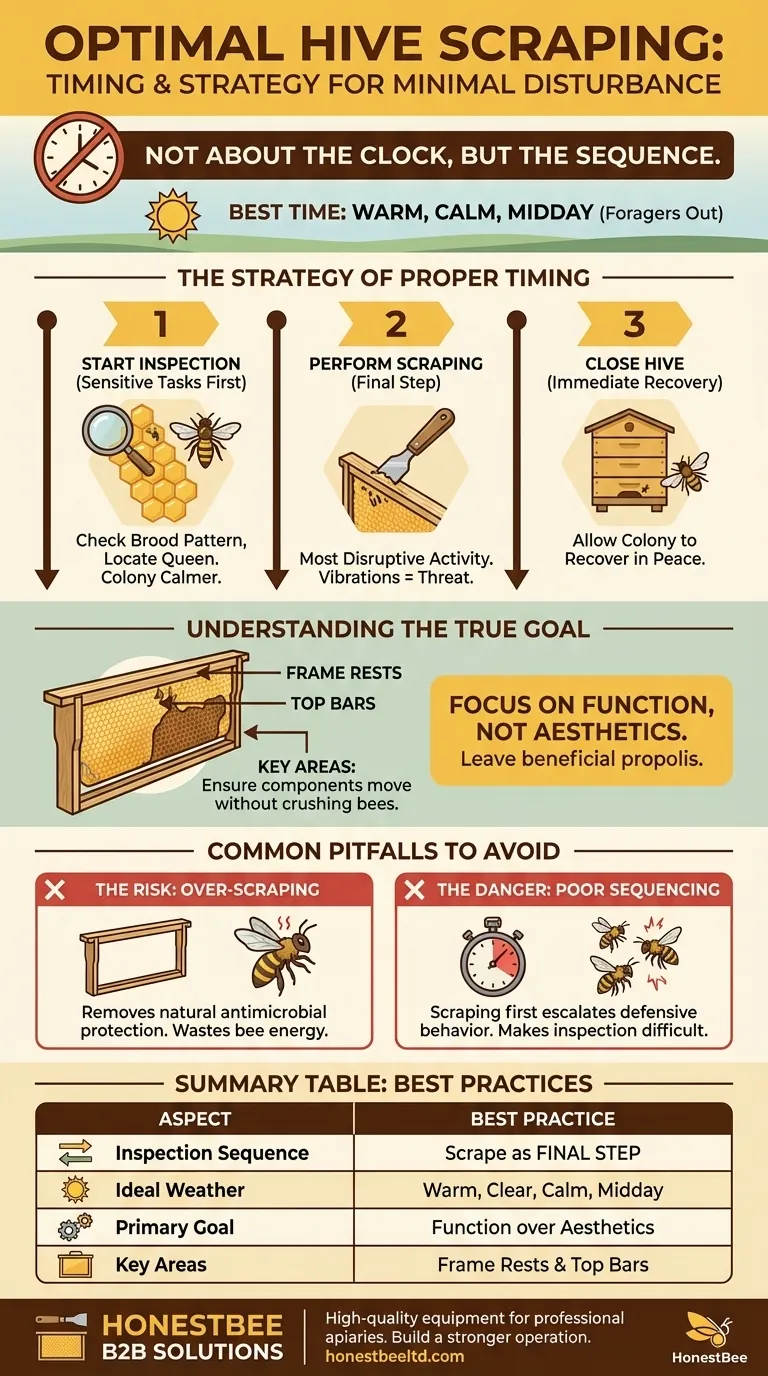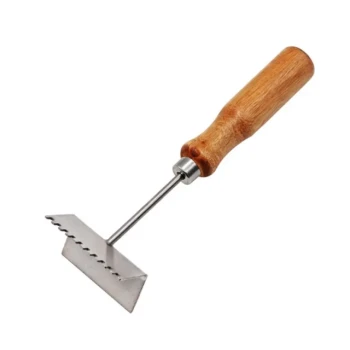The best time to scrape your hive is not about the clock, but about the sequence of your inspection. You should perform all scraping as the final step of a routine hive inspection, after all other work is complete. This inspection should ideally take place on a warm, clear, and calm day, typically around midday, when the maximum number of forager bees are out of the hive.
The core principle is to minimize disturbance. By scraping last during an inspection held on a calm, sunny day, you reduce the number of bees present and contain the most disruptive activity to the very end of your interaction.

The Strategy of Proper Timing
The timing of your maintenance is a critical factor in responsible beekeeping. The goal is to complete your tasks efficiently while causing the least amount of stress to the colony.
Choosing the Right Day and Time
The ideal conditions for any hive inspection, including scraping, are midday on a clear, still day.
This timing is strategic because many of the colony's forager bees will be out of the hive, reducing the in-hive population you have to manage. Good sunlight also provides better visibility into the hive's deep corners.
Why Scraping Must Be the Final Step
Scraping your hive tool against wood creates significant noise and vibration. Bees are extremely sensitive to these vibrations and perceive them as a direct threat, similar to a large predator trying to break into their home.
By performing sensitive tasks first—like inspecting the brood pattern or locating the queen—you work with a calmer colony. Leaving the most agitating task for last allows you to close up the hive immediately afterward, giving the bees time to recover in peace.
Understanding the True Goal of Scraping
Effective scraping is about function, not about making the inside of your hive look perfectly clean. The bees use propolis and wax to seal their home, and excessive removal can be counterproductive.
Focus on Function, Not Aesthetics
Your primary goal is to ensure hive components can be moved without crushing bees. You only need to remove enough wax and propolis to allow for the smooth movement of frames.
Key Areas for Maintenance
Concentrate your scraping efforts on the frame rests, where the ears of the frames sit. This is the most critical area for ensuring frames slide easily. You may also need to clean the top bars of the frames so the inner cover can sit flat without crushing bees.
Common Pitfalls to Avoid
Performing this simple task incorrectly can create unnecessary problems for both you and your colony.
The Risk of Over-Scraping
Propolis has natural antimicrobial properties that help protect the hive from disease. Removing all of it forces the bees to expend significant energy and resources to replace it.
The Danger of Poor Sequencing
If you scrape at the beginning of an inspection, the bees will become defensive and agitated. This makes subsequent tasks, like finding the queen, far more difficult and stressful for the entire colony.
Making the Right Choice for Your Goal
Always adapt your maintenance plan to the specific conditions of the hive and the day.
- If your primary focus is a routine health check: Complete all frame inspections first, then perform minimal scraping on the frame rests just before closing the hive.
- If your primary focus is a major cleaning or box swap: Schedule this for a perfect weather day (warm, sunny, no wind) and work efficiently, still performing the most jarring work at the end of the process.
- If the bees are already unusually defensive: Postpone any non-essential scraping for a future inspection to avoid escalating their agitated state.
By timing your maintenance with the bees' natural rhythms, you transition from an intruder to a respectful caretaker.
Summary Table:
| Aspect | Best Practice |
|---|---|
| Inspection Sequence | Perform scraping as the final step after all other tasks. |
| Ideal Weather | A warm, clear, and calm day, typically around midday. |
| Primary Goal | Ensure hive components move freely; focus on function over aesthetics. |
| Key Areas to Scrape | Frame rests and top bars of frames to prevent crushing bees. |
| Main Risk to Avoid | Over-scraping, which removes beneficial propolis and agitates the colony. |
Ensure Your Apiary Thrives with the Right Equipment
Proper hive maintenance starts with the right tools. For commercial apiaries and distributors, having durable, efficient equipment is key to minimizing colony stress during inspections and maximizing productivity.
HONESTBEE supplies high-quality beekeeping supplies and equipment designed for the demands of professional beekeeping. From reliable hive tools to full hive systems, our wholesale-focused operations ensure you get the gear you need to work efficiently and respectfully with your bees.
Let us help you build a stronger, more productive operation. Contact our team today to discuss your equipment needs and wholesale pricing.
Visual Guide

Related Products
- Professional Stainless Steel J-Hook Hive Tool
- HONESTBEE Advanced Ergonomic Stainless Steel Hive Tool for Beekeeping
- Professional Stainless Steel Frame Cleaner with Ergonomic Wood Handle
- Professional Long-Handled Silicone Honey Scraper for Beekeeping
- Professional Wide Blade Honey Scraper for Beekeeping and Honey Processing
People Also Ask
- What are the basic components of beekeeping equipment? Build a Thriving Hive from the Start
- Why is a hive tool necessary for beekeeping? Your Essential Key to Opening the Hive
- What is the function of a hive tool in beekeeping? The Essential Multi-Purpose Lever for Your Hive
- What steps are involved in cleaning and sanitizing a hive tool? A Guide to Effective Apiary Biosecurity
- How can a hive tool be cleaned and sterilized? A Beekeeper's Guide to Disease Prevention



















